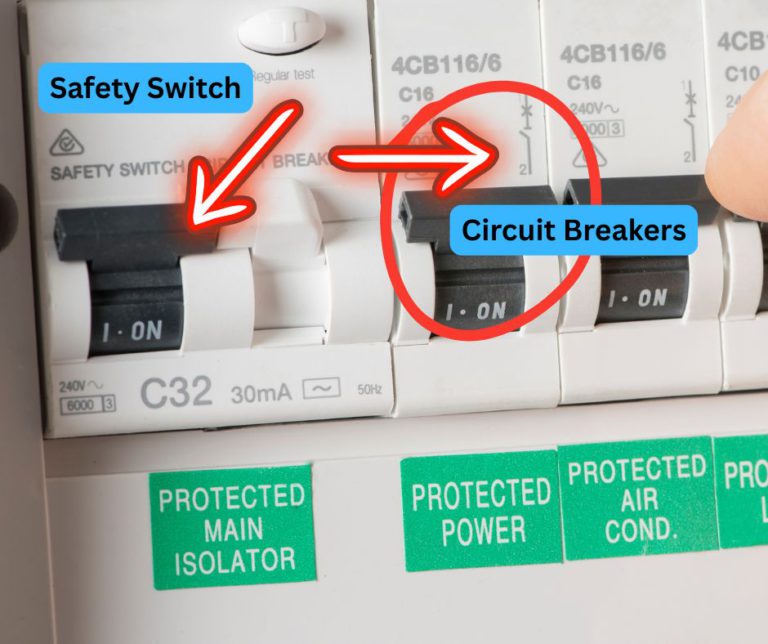Understanding the Critical Importance of Safety Switches for Home Protection
Without safety switches, commonly referred to as RCDs or Residual Current Devices, your residence is left vulnerable, lacking a vital automatic safety mechanism designed to guard against electric shock. In situations where there is an electrical fault, the power might not disconnect quickly enough, which can result in severe injuries or potentially catastrophic fires. In Victoria, it has become a legal obligation to have safety switches installed for all final circuits in residential buildings to significantly enhance safety and minimise the risk of accidents.

Unpacking the Functionality of Switchboards and the Vital Role of Safety Switches
Safety switches are essential elements of your home’s electrical system. If your switchboard does not include these critical protective devices, you are significantly jeopardising your safety. This issue is particularly serious in older homes located in areas such as Footscray, Braybrook, and Yarraville, where many long-term residents may not have upgraded their electrical infrastructures in years. While older fuse boxes equipped with ceramic fuses, cotton-wrapped wiring, or basic breakers might still appear functional, they fail to deliver sufficient protection against electric shock and other electrical hazards, posing serious risks to you and your loved ones.
Gaining a comprehensive understanding of the hazards linked to outdated electrical systems is crucial in safeguarding your household from potential dangers.
1. Defining a Safety Switch and Its Operational Mechanism
A safety switch, often known as a Residual Current Device (RCD), diligently monitors the flow of electricity in real-time. If it detects a current leak—such as from a damaged wire or an individual making contact with electrical current—it will disconnect the power within milliseconds. This swift response is what renders safety switches indispensable for averting serious accidents. Unlike conventional fuses and breakers that trip due to overcurrent, safety switches engage in response to dangerous situations, thereby ensuring your protection and peace of mind.
2. A Step-by-Step Guide to Identifying Safety Switches in Your Home
To check if your switchboard is equipped with safety switches, you should open the panel and look for certain indicators, such as:
- Labels indicating “Safety Switch”
- Labels denoting “RCD”
- A TEST button located on the circuit breaker
If you are unable to locate a test button on any of your breakers, or if your switchboard still contains ceramic fuses, this indicates that you lack RCD protection in your home. This vital information is further explained in our comprehensive Switchboard Upgrade Services.
3. Identifying the Risks Associated with the Absence of Safety Switches
Increased Likelihood of Serious Electric Shock Incidents
In the absence of a RCD, the risk intensifies significantly. If a live wire comes into contact with a person or a conductive surface, the electrical current remains active. This scenario poses an extreme danger, as neither the fuse nor the breaker will react in time to prevent a serious electric shock, which can create a life-threatening situation.
Inadequate Protection Against Appliance Failures
When appliances, such as a faulty toaster or washing machine, start leaking current, they can energise nearby metal surfaces, leading to severe injury. Fortunately, RCDs are specifically designed to swiftly detect these hazardous faults, providing essential protection that could potentially save lives.
Non-Compliance with Current Safety Regulations
All residences constructed or renovated after 1991 in Victoria are mandated by law to have safety switches installed on power circuits. As of 2007, this requirement also extends to lighting circuits. For complete guidelines, refer to the documentation provided by Energy Safe Victoria.
4. Identifying Indicators That Your Switchboard Is Outdated and Unsafe
- Lack of “TEST” buttons on breakers
- Presence of outdated ceramic fuses
- Power outlets emitting buzzing sounds or feeling warm to the touch
- Only a single circuit powering the entire household
- Insufficient space for adding additional breakers
- Frequent flickering lights or tripped circuits when using multiple appliances
If you observe any of these concerning signs, we highly recommend checking out our switchboard service page. Our expertly trained team can conduct a thorough evaluation of your switchboard and provide you with a detailed quote right on the spot.
5. Our Comprehensive Approach to Upgrading Your Switchboard
During our thorough upgrade procedure, we will:
- Conduct a meticulous examination of your current switchboard and electrical circuits
- Remove any obsolete ceramic fuses or breakers
- Install modern RCBOs that integrate both circuit breaker and safety switch functions
- Clearly label every circuit for easy identification and access
- Provide a Certificate of Electrical Safety upon the successful completion of the upgrade
- Coordinate any necessary temporary power shutdowns to ensure safety throughout the process
Moreover, we can strategically divide lighting and power across separate circuits, greatly enhancing both the safety and efficiency of your home’s electrical system.
6. Is a Complete Switchboard Replacement Necessary?
In most instances, the answer is yes. Simply adding safety switches to an older switchboard may not be the safest or most effective approach. We often recommend a full switchboard replacement if:
- You are still utilising rewireable fuses
- Visible indications of overheating or corrosion are present
- You plan to include additional circuits or electrical appliances
- Your insurance provider mandates a compliant switchboard for coverage

Frequently Asked Questions About Safety Switches
Are safety switches legally mandated?
Yes, safety switches are a legal requirement for all newly constructed homes and major renovations. Older residences must have these devices installed whenever significant electrical work is undertaken.
How frequently should safety switches be tested for optimal functioning?
It is advisable to test safety switches every three months. Simply press the TEST button to confirm that it trips as intended. If it fails to trip, this indicates a malfunction, and you should arrange for a replacement without delay.
Can I retain my old fuse box and merely add one RCD?
While it is technically feasible to do this, it is seldom recommended. Older fuse boards are not constructed to protect against the demands of contemporary electrical circuits.
Will my power supply be temporarily interrupted during the upgrade?
Yes, there will be a temporary disruption to your power supply. However, we will make every effort to minimise downtime and will liaise with your energy distributor to ensure a smooth transition.
Enhance Your Home’s Safety and Compliance by Upgrading Your Switchboard Today
Running your home without safety switches exposes you to considerable risks linked to electrical faults. A single electrical fault can lead to severe electric shock, fire hazards, or other dire consequences.
We specialise in efficiently upgrading your switchboard, ensuring it adheres to all safety standards with complete certification, so your home remains compliant with contemporary safety regulations rather than outdated practices.
For more information, explore our Switchboard Upgrade Services in Melbourne.
No Safety Switches on Your Switchboard? Here’s Why That’s Not Safe
The Article: Safety Switches on Your Switchboard: Why They’re Essential first appeared on https://writebuff.com
The Article Essential Safety Switches for Your Switchboard Was Found On https://limitsofstrategy.com
References:
https://limitsofstrategy.com/essential-safety-switches-for-your-switchboard/









